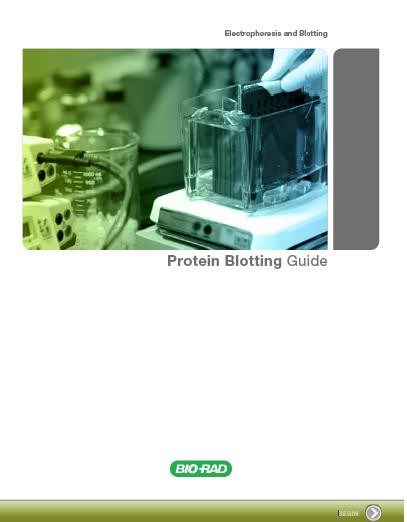This is a VERY IMPORTANT video for anyone doing Western Blotting (i.e. everyone!).
Posts Tagged ‘western blotting’
Can We Trust Western Blots?
:: Posted by American Biotechnologist on 07-08-2014The Answer to Fading Western Blots
:: Posted by American Biotechnologist on 05-29-2014Publications have become very strict when it comes to publishing research that includes images of blots, often requiring images of the full blot, uncut. To keep the membranes uncut, researchers often reprobe which can cause the marker to fade.
Bio-Rad has launched the brightest protein marker available to researchers which addresses such challenges. The Precision Plus Dual Protein Standard is not only brighter, but also stays on the membrane longer. This allows researchers to identify proteins more effectively and have greater confidence in their western blots.
The strong marker persistence of the Precision Plus Protein™ Dual Color Standards throughout electrophoresis and western blotting, even during rigorous stripping and reprobing protocols, makes the product a more effective tool for monitoring separation and estimating protein molecular weights.
“Providing the images of the entire blot is good practice for science and publications,” said Dr. Federica del Monte, assistant professor of medicine at Harvard Medical School. “In order to reprobe for the loading control and keep the membranes uncut, we sometimes need to strip them. This often results in fading of the markers. The ability to publish clear blots with the marker still on is very important.”
Key benefits of the new Precision Plus Protein Dual Color Standards include:
- Increased brightness — better identification of target proteins on gels and blots as well as easier monitoring of gel electrophoresis and confirmation of transfer quality
- Stronger marker persistence — marker remains on the blot even under the most rigorous conditions, boosting confidence in your western blots; stronger marker persistence also facilitates accurate molecular weight estimation
Bands in the Precision Plus Protein Dual Color Standards range from 10 to 250 kD with sharp pink reference bands at 25 and 75 kD for simple visualization. The new Dual Color Standards share the same migration pattern as their previous iteration.
Designing the Perfect Quantitative Western Blot
:: Posted by American Biotechnologist on 04-02-2014A methods article published yesterday provides a rigorous and concise workflow with specific instructions on how to produce and analyze quantitative data using western blot experiments. The paper, coauthored by Bio-Rad scientists and published in BioMed Research International, also highlights recently introduced technologies that improve reproducibility. The result is a powerful, step-by-step guide to obtaining quantitative and reproducible densitometric data from western blots regardless of the specific experiment.
Although western blotting is a well-established laboratory technique, it has recently come under fire as a quantitative method because extreme care must be taken when generating and interpreting the resulting data.
The technique is challenging and requires following a rigorous methodology to achieve reproducible and quantitative data. According to a recent survey of more than 750 labs, 41% of researchers say their western blots fail a quarter of the time.
Dr. Aldrin Gomes, an assistant professor at University of California, Davis, agrees that flawed western blots are not unusual. To compare expression of a protein of interest from sample to sample, protein abundance is commonly normalized to a housekeeping gene. “When I see a large, dense band for the protein of interest or the housekeeping protein, I cringe,” says Gomes. That dense band usually means the protein of interest or housekeeping protein was no longer within the assay’s linear dynamic range. No accurate quantitative data can be extracted from such blots.
Sean Taylor discusses the BioMed Research International paper he coauthored.
Another common reason for failure of quantitative western blots is flawed or incomplete protocols, according to Sean Taylor, the paper’s lead author and a Bio-Rad field application scientist (watch a video of him discussing the paper on the left). To address this, Taylor’s review pays special attention to experimental design and sample preparation and discusses proper definition of the linear dynamic range of protein loading, all key factors for generating meaningful quantitative western blot data.
Taylor also introduces more advanced concepts to improve reproducibility, simplify workflow, and reduce the time and cost of western blotting. One such technique is stain-free total protein normalization, which over the past year has proven superior to using housekeeping proteins or total protein staining to correct for loading errors.
With this article, Taylor hopes researchers now have a simple guide to ensure quantitative and reproducible western blot data for all research fields that rely on this technique.
To read the open access research article, visit http://bit.ly/1kCAOcr.
For additional resources please consult Bio-Rad’s guide to Troubleshooting Western Blots.
Video: How to Perform Perfect Quantitative Western Blotting
:: Posted by American Biotechnologist on 04-01-2014What You Don’t See Truly Matters
:: Posted by American Biotechnologist on 11-13-2013All gels are not created equal when it comes to protein transfer. Mini-PROTEAN® TGX™ precast gels, together with the Trans-Blot® Turbo™ transfer system, offer you a complete solution for achieving fast electrophoresis and transfer times. In addition to speed, these innovative gels deliver maximum transfer of proteins onto membranes so you don’t see proteins left behind on the gel, ensuring quality western blotting results you can count on every time.
For more information visit Bio-Rad Laboratories TGX™ precast gel page.
















